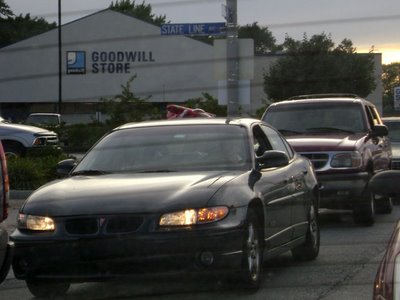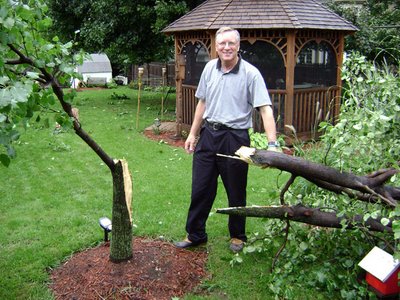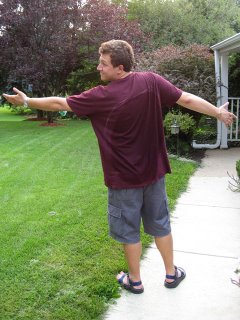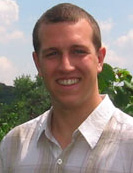Day 12: Wheaton, IL to Indianapolis, IN Muskegon, MI

Image of the day: The Illinois-Indiana State Line. It took me hours longer than normal to get this far on the trip.
Trip meter at start of day: 1,006.0 mi
Gas: $2.889/gal
"Well, you were right, Aunt Jane," I admitted over the phone. "I should never have left Wheaton today."
This morning, I had been so happy to move on with my trip, and so sure that I would bypass any problems caused by the storms and flooding of the previous two days. Now, it was already 4 p.m. and I still hadn't crossed into Indiana. I had to call Aunt Jane and tell her she had been right.
Like Aunt Jane, I too had had my doubts this morning. Power was still out across most of Wheaton, and as we drove to the grocery store in the morning, trees were down everywhere. But I was eager to continue on the road, and also to see Tammy, a Peace Corps friend of mine, in Indianapolis. After lunch, Claire and I said goodbye to Aunt Jane, got into the car, and drove in to Chicago. I dropped my sister off at her apartment, and prepared for the first solo leg of my trip.
Now that I'm on the road by myself, it's a good time to introduce my rules for the trip:
- Visit every state I've never been to before. I've already been to 34 states, leaving Alabama, Alaska, Arizona, Arkansas, Idaho, Kentucky, Minnesota, Mississippi, Montana, New Mexico, North Dakota, Oklahoma, Oregon, Tennessee, Washington and West Virginia. The one state that I won't visit on this trip is Alaska; I'll save that for a special trip.
- No driving for more than seven hours in a day. If you're always in your car, you're not seeing things. I feel no pressure to rush from one place to another, so I won't go on any crazy 17-hour drives like I have at other times in my life. This trip is a circle from California to California, so if I were in such a rush to get to my destination, I wouldn't have left at all.
- No interstates. A lot of people think I'm stupid for adding this rule. Conventional wisdom says that the interstates have simplified travel and made it safer. I don't know if it's safer, but it's certainly more sterilized. Americans can drive from San Francisco to New York without hitting a stoplight, without driving through a bad neighborhood, and without eating anything other than McDonald's. For many Americans, this is a comfort and symbol of national unity; for me, it's a road to division. The more that Americans are able to cocoon themselves, whether it be in private schools, neighborhoods of new-money McMansions or anonymous Arby's restaurants that look the same in every state, the less we as a people understand one another. Driving is one of the few ways left that people of all sorts can interact, and the interstates have taken much of that away from us. In order to see America, you have to leave the interstates.
I started the day with those three rules, and I broke two of them. From my sister's apartment, I planned to travel through the South Side of Chicago and through some of the southern suburbs until I got to the Lincoln Highway. I would take the Lincoln Highway across the Illinois-Indiana border, then take Highway 41 south toward Indianapolis. The first part of the plan went well; then it got bad fast.
I drove down Lake Shore Drive until it ended, and then headed west to Halsted Street. I was on the South Side, which is predominantly black. A lot of white folks in Chicago wouldn't venture to the South Side, but I hope to teach in the public schools here next year, so I can't afford to feel uncomfortable in this part of the city.
As I drove south down Halsted, the things I noticed most were the churches. There seemed to be a church on every block, and they were simple one-story buildings that from the outside could have just as easily been doctors' offices or insurance companies. These churches were not focused on looks to attract their congregation; instead, it seemed that the minister's name itself was a draw, as each church's marquee displayed the minister's name in big black block letters.
I continued down Halsted, which became Route 1, out of Chicago to Chicago Heights. I turned onto Highway 30, the Lincoln Highway, drove a couple miles east, and thenÑ
Nothing. All traffic stopped. It was long before rush hour, yet the Lincoln Highway, which I thought would be a little-used four-lane road where I could drive 55 mph across the border, was backed up for miles.
I sat. I waited. I called Tammy and told her I would be late. I listened to a podcast about psychology. I called my buddy, Mike. Hours passed, and all I had driven was maybe 5 miles, including a part of the road which was flooded with five inches of water. I called my grandma in Muskegon and asked if I could show up a day early. When she said yes, I called Tammy again and told her I would have to skip Indianapolis. Then I waited some more, as the highway patrol directed everyone away from the Lincoln Highway, which was closed due to flooding just short of the Indiana border.
I followed the long line of cars until I saw a strip of convenience stores and small-time fast food restaurant. I needed to use the bathroom, so I parked and walked over to a spot advertising BBQ in its window. A guy was mopping in the back, and told me that the only bathroom was at the barber shop at the end of the strip. I walked further, past a couple of other chicken shacks, until I reached the barber shop.
As a white guy, I will never understand what appeals to black men about hanging out at the barber shop. I don't like paying money to have my hair cut, and I've never especially wanted to socialize with one of my barbers or with anyone else who was getting their hair cut at the barber shop. I have some ideas as to how barber shops became such important hangouts, but my theories are probably wrong, so I won't bother writing them. What matters to this story is that the guys working there let me use the bathroom, and then they gave me some driving advice. They told me that I-80/94, the major interstate from Chicago to Northwest Indiana, was flooded and closed for miles, forcing all of the normal interstate traffic to come through the streets of the small towns alongside the freeway. The guys at the barber shop also told me about a shortcut, which took me through a residential area and probably saved me 20 minutes of driving.
Eventually, I got to the non-flooded part I-80/94, breaking my third rule of not using the interstates. After hours of not moving, I couldn't do state roads anymore, and I needed to move fast again. The rest of the trip went quickly and smoothly: I found the White Sox-Red Sox game on Chicago radio, which miraculously gave me clear reception all the way to Muskegon; I stopped at a Michigan gas station, where four attractive girls were having car trouble, and I wished that I knew more about cars so that I could help them; I bought a cheeseburger at McDonald's for 99 cents, and then saw that a double cheeseburger costs the same amount of money; I found my grandma's new house just before 11 p.m., parked, got the tour, and got ready to go to sleep.
I had driven for too long and on too big of roads. I had broken two of my rules, out of both disgust and necessity. It's okay to break rules, I suppose. A road trip has to be open to improvisation.
Labels: Chicago, I-80, I-94, Illinois, Indiana, Indianapolis, Lincoln Highway, Michigan, Muskegon, rules, Wheaton




